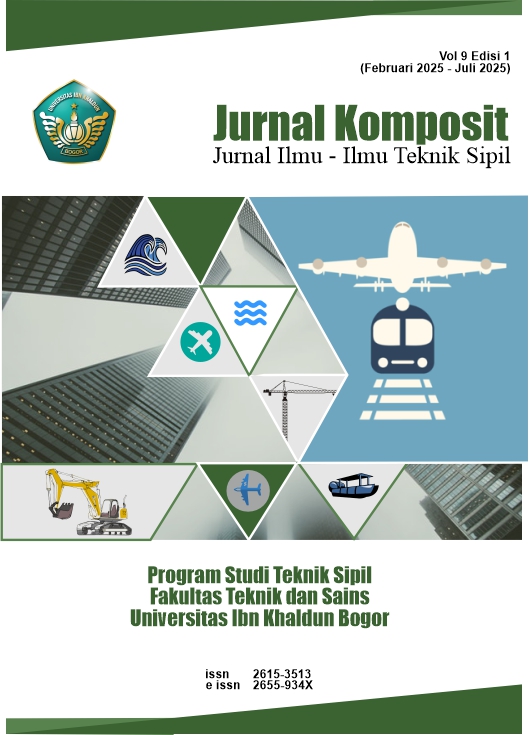Analisis Waktu pada Pekerjaan Tambahan Proyek Pembangunan Gedung PT. Petrokimia Gresik
DOI:
https://doi.org/10.32832/komposit.v9i1.16449Keywords:
konsep nilai hasil, variasi jadwal, BCWS, BCWP, pekerjaan tambahAbstract
The time analysis of the additional work of the PT. Petrokimia Gresik Building Construction project aims to determine the delay and acceleration during the implementation of additional work to meet the SLF (Certificate of Functioning) requirements on the work items of emergency stairs, fire extinguisher, GWT and electrical which have a contract value of Rp 3,556,641,848, - with a planned project completion time of 19 weeks located on Jl. Tanah Abang II no. 63, Central Jakarta, DKI Jakarta. In this study using the Earned Value Concept method, which is a method that can analyze time and provide an overview of conditions at the time of realization which includes indicators in the form of BCWS and BCWP. At the time of the implementation of the additional work, in fifth weeks to twelveth seen from the value of the schedule variant (SV) shows a positive number (+) which means the work is carried out faster than planned. However, the evaluation of week 15 to week 17 seen from the schedule variance value (SV) has a negative value (-) which means there is a delay from the plan schedule at the time of implementation. But the delay did not really affect the project completion time at the end because previously there was an acceleration of work. At the end of the SPI calculation, it has a value of 1 = 1, which means that the work implementation time is in accordance with the planned time of 19 weeks.
References
Alfiana. (2021). Mendefinisikan Proyek. i H. Hosaini, H. Hartoto, A. Alfiana, C. D. Sitindaon, L. Saptaria, R. Rudi, . . . R. Kristiana , Manajemen Proyek (ss. 36-53). Bandung: Widina Bhakti Persada.
Astuti, R., Chayati, N., & Taqwa, F. (2018). Pengendalian Waktu Proyek pada Pembangunan Atap Stadion Renang Aquatic Senayan dengan Metode CPM. Seminar Nasional Pascasarjana Departemen Teknik Sipil Universitas Indonesia. 1, ss. 383-391. Depok: Departemen Teknik Sipil Universitas Indonesia.
Atmaja, J., Wijaya, Y. P., & Hartati. (2016). Pengendalian Biaya dan Waktu Pada Proyek Konstruksi dengan Konsep Earned Value (Studi Kasus Proyek Pembangunan Jembatan Beringin – Kota Padang). Jurnal Rekayasa Sipil Politeknik Negeri Andalas, 23-30. http://ejournal.polinpdg.ac.id/index.php/JRS/article/view/4
Bahri, M., & Sembiring, K. (2023). Analisis Kinerja Waktu Menggunakan Metode Earned Value Pada Proyek Pembangunan Gedung Kejaksaan Tinggi DKI Jakarta. Jurnal Teknika, 107-116. https://doi.org/10.30736/jt.v15i2.1086
Deshariyanto, D., & Fansuri, S. (2013). Faktor – Faktor yang Mempengaruhi Waktu Pelaksanaan Proyek Konstruksi di Dinas PU. Bina Marga Kabupaten Sumenep. Jurnal Ilmiah MITSU, 1(2), 1-11. doi: https://doi.org/10.24929/ft.v1i2.59
Febriana, W., & Aziz, U. (2021). Analisis Penjadwalan Proyek dengan Metode PERT Menggunakan Microsoft Project 2016. Surya Beton: Jurnal Ilmu Teknik Sipil, 37-45. https://jurnal.umpwr.ac.id/index.php/suryabeton/article/view/1107
Hayati, N. I., & Lugi, D. (2022). Evaluasi Biaya dan Waktu Dengan Metode Earned Value Management (Studi Kasus: Ruko Damara Village, Kel. Ciparigi, Kota Bogor). Jurnal Komposit: Jurnal Ilmu-Ilmu Teknik Sipil, 4(2), 61-65. doi: https://doi.org/10.32832/komposit.v4i2.3760
Kementerian PUPR. (2019). Permen PUPR 27/PRT/M/2018 tentang Sertifikat Laik Fungsi Bangunan Gedung. Jaringan Dokumen dan Informasi Hukum . https://jdih.pu.go.id.
Mardiaman. (2022). Perencanaan dan Penjadwalan Konstruksi. Jakarta: KBM Indonesia.
Maromi, M. I., & Indryani, R. (2015). Metode Earned Value untuk Analisa Kinerja Biaya dan Waktu Pelaksanaan pada Proyek Pembangunan Condotel De Vasa Surabaya. Jurnal Teknik ITS, 4(1), 54-59. doi:10.12962/j23373539.v4i1.8970
Munarlis, P., Hikma, D., & Kristina, S. (2023). Analisis Penjadwalan dengan Menggunakan Time Schedule Kurva S Pada Proyek Pembangunan kantor Cabang BRI Otista. Jurnal Teknika, 9-22. https://doi.org/10.30736/jt.v15i1.916
Priyo, M., & Zhafira, T. (2017). Penerapan Metode “Earn Value” dan “Project Crashing” pada Proyek Konstruksi: Studi Kasus Pembangunan Gedung IGD RSUD Sunan Kalijaga, Demak. Jurnal Ilmiah Semesta Teknika, 20(1), 29-50. doi:https://doi.org/10.18196/st.v20i1.2434
Salim, M. A., & Siswanto, A. B. (2020). Manajemen Proyek. Semarang: CV. Pillar Nusantara.
Waldi, B., & Sembiring, K. (2016). Analisa Penerapan Manajemen Waktu Dan Biaya Pada Proyek Pembangunan Hotel BW Luxury Jambi. e-Jurnal Jagakarsa, 11(3). https://tinyurl.com/ejurnaltama232
Downloads
Published
How to Cite
Issue
Section
License
Copyright (c) 2025 Jurnal Komposit: Jurnal Ilmu-ilmu Teknik Sipil

This work is licensed under a Creative Commons Attribution-NonCommercial-ShareAlike 4.0 International License.
Authors who publish with this journal agree to the following terms (Penulis yang mengajukan publikasi artikel telah menyetujui hal berikut):
- Through this publication, the author agree to submit the copyright of article writing to Jurnal Komposit: Jurnal Ilmu-ilmu Teknik Sipil. This copyright submission takes the form of, but is not limited to: reproduction of the article and parts therein, including photographic reproductions; distribution of articles through printed and electronic documents; and translation of articles(Bahwa melalui publikasi ini, hak cipta penulisan artikel diserahkan kepada Jurnal Komposit: Jurnal Ilmu-ilmu Teknik Sipil. Penyerahan hak cipta ini berupa, namun tidak terbatas pada: perbanyakan artikel dan bagian di dalamnya, termasuk reproduksi fotografi; penyebarluasan artikel melalui dokumen cetak dan elektronik; serta penterjemahan artikel).
- The authors agree to the terms of the Copyright Notice, according to Creative Commons Attribution-NonCommercial-ShareAlike 4.0 International License., which will apply to this article if and when it is published by Jurnal Komposit: Jurnal Ilmu-ilmu Teknik Sipil. (Para penulis setuju dengan ketentuan Pemberitahuan Hak Cipta, sesuai dengan Lisensi Internasional Creative Commons Attribution-NonCommercial-ShareAlike 4.0., yang akan berlaku untuk artikel ini jika dan ketika diterbitkan oleh Jurnal Komposit: Jurnal Ilmu-ilmu Teknik Sipil).

This work is licensed under a Creative Commons Attribution-NonCommercial-ShareAlike 4.0 International License.



.png)










